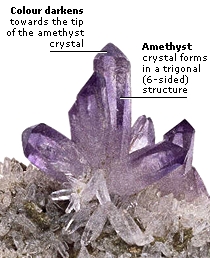DK Science: Minerals
Minerals are the materials that make up the rocks of the Earth’s crust. Among thousands of different minerals, only a few, including quartz, feldspar, and calcite, form most rocks. Native minerals, such as gold and copper, contain one chemical element. Compound minerals, such as quartz, contain two or more chemical elements. Most minerals are made up of CRYSTALS and can be described by their properties.
The colour of a mineral’s crystal, its surface shine (lustre), and the form (habit) made by a group of its crystals.

A mineral is easy to identify when it is in the form of large crystals, such as these amethyst crystals. Then the colour, lustre, habit, and system of the crystal can be seen more clearly. Amethyst has a purple colour, a glassy lustre, a white streak, a hardness of 7 on Mohs scale, and hexagonal crystals that grow into flat six-sided columns.
The colour of a streak of powder left by the mineral when it is rubbed across an unglazed porcelain tile.
Resistance to scratching, measured on Mohs scale, going from 1 (talc, very soft) to 10 (diamond, very hard).
In rock, minerals are normally found as tiny grains. It is harder to identify minerals in rock than when they are in the form of large crystals because the grains are often very small and do not have typical crystal shapes. One method used is to view a thin slice of rock under a microscope in polarized light. The minerals then show up in different colours, as in this piece of mica schist.
Minerals come in the form of crystals. This means that the mineral’s atoms (small particles) are arranged in a regular way, in neat rows and columns. The arrangement is not obvious when you look at mineral grains in rocks, but a free-growing crystal always forms a geometric shape, with flat faces. A crystal is normally symmetrical. All crystals form in one of six systems of symmetry, which help identify them.

A geode is a cavity in a piece of rock that is filled with concentric layers of minerals and crystals. This agate geode has been cut in two and polished, revealing a beautiful banded pattern. The layers of crystals grow from the outside inwards when water containing dissolved minerals flows into the rock cavity. Geodes are often found in lavas.
A gemstone, such as garnet, is a crystal found in rock, that is used for jewellery or other decoration. Raw (uncut) gemstones are cut and polished before they are used. Gemstones are also called precious stones because of their beautiful colours, hardness, and rarity. The most prized gemstones include diamond, ruby, sapphire, and emerald.



